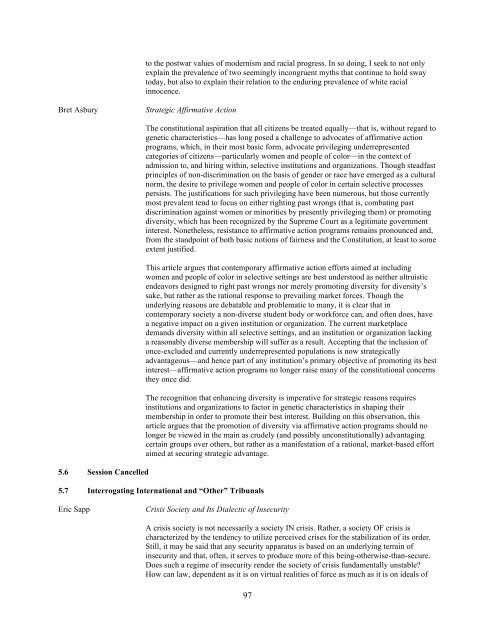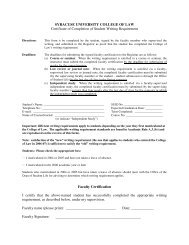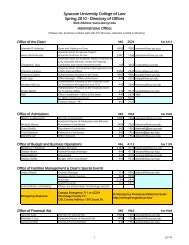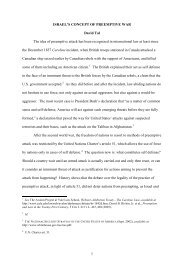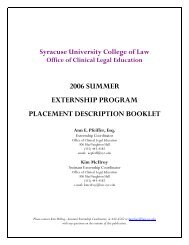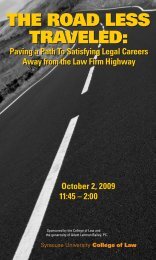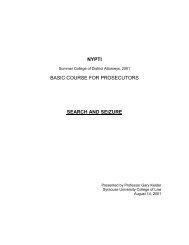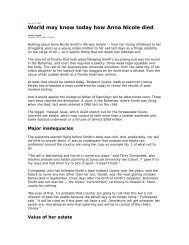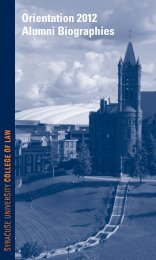2011 Conference Program (PDF) - Syracuse University College of Law
2011 Conference Program (PDF) - Syracuse University College of Law
2011 Conference Program (PDF) - Syracuse University College of Law
You also want an ePaper? Increase the reach of your titles
YUMPU automatically turns print PDFs into web optimized ePapers that Google loves.
to the postwar values <strong>of</strong> modernism and racial progress. In so doing, I seek to not only<br />
explain the prevalence <strong>of</strong> two seemingly incongruent myths that continue to hold sway<br />
today, but also to explain their relation to the enduring prevalence <strong>of</strong> white racial<br />
innocence.<br />
Bret Asbury<br />
Strategic Affirmative Action<br />
5.6 Session Cancelled<br />
The constitutional aspiration that all citizens be treated equally—that is, without regard to<br />
genetic characteristics—has long posed a challenge to advocates <strong>of</strong> affirmative action<br />
programs, which, in their most basic form, advocate privileging underrepresented<br />
categories <strong>of</strong> citizens—particularly women and people <strong>of</strong> color—in the context <strong>of</strong><br />
admission to, and hiring within, selective institutions and organizations. Though steadfast<br />
principles <strong>of</strong> non-discrimination on the basis <strong>of</strong> gender or race have emerged as a cultural<br />
norm, the desire to privilege women and people <strong>of</strong> color in certain selective processes<br />
persists. The justifications for such privileging have been numerous, but those currently<br />
most prevalent tend to focus on either righting past wrongs (that is, combating past<br />
discrimination against women or minorities by presently privileging them) or promoting<br />
diversity, which has been recognized by the Supreme Court as a legitimate government<br />
interest. Nonetheless, resistance to affirmative action programs remains pronounced and,<br />
from the standpoint <strong>of</strong> both basic notions <strong>of</strong> fairness and the Constitution, at least to some<br />
extent justified.<br />
This article argues that contemporary affirmative action efforts aimed at including<br />
women and people <strong>of</strong> color in selective settings are best understood as neither altruistic<br />
endeavors designed to right past wrongs nor merely promoting diversity for diversity’s<br />
sake, but rather as the rational response to prevailing market forces. Though the<br />
underlying reasons are debatable and problematic to many, it is clear that in<br />
contemporary society a non-diverse student body or workforce can, and <strong>of</strong>ten does, have<br />
a negative impact on a given institution or organization. The current marketplace<br />
demands diversity within all selective settings, and an institution or organization lacking<br />
a reasonably diverse membership will suffer as a result. Accepting that the inclusion <strong>of</strong><br />
once-excluded and currently underrepresented populations is now strategically<br />
advantageous—and hence part <strong>of</strong> any institution’s primary objective <strong>of</strong> promoting its best<br />
interest—affirmative action programs no longer raise many <strong>of</strong> the constitutional concerns<br />
they once did.<br />
The recognition that enhancing diversity is imperative for strategic reasons requires<br />
institutions and organizations to factor in genetic characteristics in shaping their<br />
membership in order to promote their best interest. Building on this observation, this<br />
article argues that the promotion <strong>of</strong> diversity via affirmative action programs should no<br />
longer be viewed in the main as crudely (and possibly unconstitutionally) advantaging<br />
certain groups over others, but rather as a manifestation <strong>of</strong> a rational, market-based effort<br />
aimed at securing strategic advantage.<br />
5.7 Interrogating International and “Other” Tribunals<br />
Eric Sapp<br />
Crisis Society and Its Dialectic <strong>of</strong> Insecurity<br />
A crisis society is not necessarily a society IN crisis. Rather, a society OF crisis is<br />
characterized by the tendency to utilize perceived crises for the stabilization <strong>of</strong> its order.<br />
Still, it may be said that any security apparatus is based on an underlying terrain <strong>of</strong><br />
insecurity and that, <strong>of</strong>ten, it serves to produce more <strong>of</strong> this being-otherwise-than-secure.<br />
Does such a regime <strong>of</strong> insecurity render the society <strong>of</strong> crisis fundamentally unstable<br />
How can law, dependent as it is on virtual realities <strong>of</strong> force as much as it is on ideals <strong>of</strong><br />
!<br />
97


